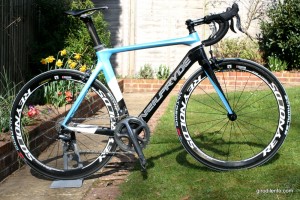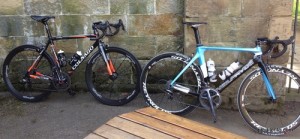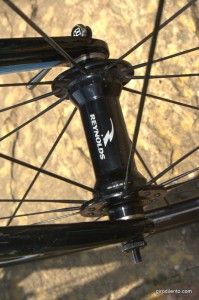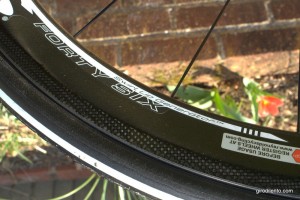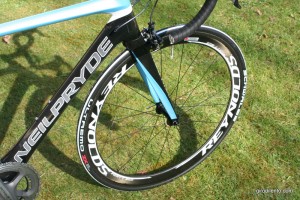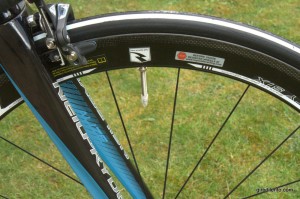A few weeks ago I had the depressing task of taking the Forty Six’s off my bike, boxing them up and waiting for the courier to come and take them away. To be honest, I was pretty gutted as I’d thoroughly enjoyed them and had been vainly (and foolishly) hoping that Paddy at Reynolds might have just forgotten I had them for the next year or so. I really did enjoy them that much. At least I managed to not actually cry when the courier arrived.
I’ve already written some early impressions on the wheels here: http://girodilento.com/first-look-reynolds-forty-six-carbon-clincher and it’s worth revisiting this to get the full story.
Whilst I had the Forty Six’s I successfully managed to convince myself to ride them as my everyday wheels on my best bike. I did have to convince myself to do this though as I kept thinking “do I really want to be going out and riding £2k wheels on the rough potholed roads around where I live?” As it turns out the answer was a resounding YES I DO. I wanted to not “baby” them but to just to ride them because I don’t believe that if you’re going to buy wheels of this calibre that they should only be for “Sunday best”.
In total I rode for just over 400km on the Forty Sixes during a period of about three weeks over all types of local surfaces and terrain, from flat to 10%+ gradients from smooth to very rough road surfaces with plenty of climbing and descending. It seems amazing to be saying this after the last few weeks of weather – but I didn’t get to ride them in the rain, nor did I get to ride them in a strong wind.
Without fail, every time I rode the Reynolds, they felt fast regardless of conditions or terrain. They are stiff wheels and the ride quality is noticeably less comfortable than my alloy clinchers but no alloy clincher I’ve ridden was as fun to ride as these. The light weight of wheels (just over 1400gms a pair for a 46mm deep rim) made them a pleasure to climb with. I’m not the strongest or most powerful of riders but I was able to attack and accelerate with the Reynolds on surprisingly steep climbs.
Unscientifically, the wheels started to feel like the aero aspect was working once you pushed past 20kmh and then stepped up again once you got past 35kmh. Over the test period I set a bunch of personal best times on various local climbs and descents and I was far from my peak of fitness.
The hubs also have a fantastic sound and each time I rode with other people, the noise they made was always complimented. Whilst the hubs are labelled Reynolds, they are in face a DT Swiss 240 outer shell with DT 190 internals, so they’re very high quality, expensive and roll very well indeed. This is one of a few differences between the Forty Sixes and the Reynolds Assault, which is Reynolds more affordable 46mm carbon wheelset. In addition to the hubs, other upgrades on the Forty Six versus the Assault include: bladed DT Swiss Aerolite spokes versus the marginally heavier non-bladed DT Revolution spokes on the Assault. The Forty Six also features the Reynolds Swirl Lip Generator where the Assault’s don’t.
The Swirl Lip Generator is an aerodynamic feature which is a little bit like a spoiler on the inside edge of the rim. It’s not a large lip but it breaks up the airflow where the rim and spokes meet and improves the overall aero performance of the wheel according to Reynolds. I’m no aero expert but it makes sense to me that something like this could help.
A further and important difference between the Assaults and the Forty Six is that the more expensive wheel features higher modulus carbon in the rims and the rims are made from longer sections of carbon fibre during the manufacturing process to improve the ride quality of the more expensive wheels. This means that more carbon is used in the manufacturing of the Forty Six again pushing the price up.
So in total the Forty Six have higher quality hubs, better spokes (bladed) and rims that are both a step up in engineering, manufacturing, ride quality and aerodynamics not to mention graphics that are much more elegant. This dear readers is also why they’re a decent step up in price over the Assaults.
Back to actually riding the Forty Six, some of the things that most stood out to me whilst out riding were: How easily it was hold a good clip of speed on the flat. It definitely took less effort to roll along in the high 30’s kmh. Sitting on someone’s wheel also required noticeably less effort on the Reynolds, even with just one other rider in front. These are wheels to put on when you’re going out with your fastest riding buddies – they really did help me. I’ve already mentioned how well they climbed on both steep and gradual climbs. On shallower climbs I felt I could carry a higher speed more comfortably than normal as they just feel light on your bike. As I’ve said before I really, really enjoyed these wheels.
What’s the catch? I mean it can’t be all sweetness and light can it? Well, I don’t think there’s a catch as such because I genuinely think these are a great set of wheels. However, what I did notice that’s something to keep in mind also applies to many other carbon wheels too. The stiffness of the rims translates into a less comfortable ride than my alloy rimmed wheels. I found myself naturally riding towards the smoothest bits of tarmac on the road in a way I don’t with alloy clinchers. A friend with a pair of Lightweight Clinchers told me he rides the same with them too, so it’s not just a Reynolds thing. What I found most noticeable in terms of riding differently was during descents. Normally I’m a pretty quick descender but given the harder ride quality of the Reynolds I found myself descending more slowly to read the road surface more carefully and pick my path – particularly on tree lined rough surfaced descents (i.e. most UK descents!) where the light changes and can be quite shaded in places. To be clear I didn’t find it a problem but I did adjust my style because of it. I don’t think it should put you off either – it’s just recognition that to get the best out of the wheels requires a slightly different riding approach.
Another point to mention is braking. Carbon rims for a long time have been infamous for not braking as well as alloy rims and to be honest – these still don’t but the braking was very good. I normally ride on the hoods most of the time and I found that the Forty Six would scrub off speed well braking via the hoods. When I really wanted to stop in a hurry I needed to move my hands fully onto the brake levers and then they very stopped well indeed. My test bike has Dura Ace 7900 calipers which are good brakes and I ran the Reynolds Blue Cryo pads which can apparently lower braking temperatures by around 50 degrees over normal pads.
However even given the observations above I didn’t once think about taking them off my bike and riding my alloy clinchers instead whilst I had them. Far from it in fact. The performance benefits significantly outweighed any of the slightly less positive aspects.
Every time I rode the Reynolds Forty Six wheelset I felt like I was cheating. My bike was faster, held its speed better and climbed and descended as well as it ever has. I set a bunch of personal bests whilst not at my best fitness levels and I kept up with my fitter, faster riding buddies much more easily than I had expected too. They looked fantastic on my bike and to me aesthetically are a great depth. Shallow enough to be light and climb well, deep enough to look great and deliver some tangible aero benefit. These wheels are credit card speed and that’s a very compelling proposition as long as you can afford to hand over your plastic. These are a very high quality set of deep section carbon clinchers that you can confidently ride every day and on any type of road terrain. I thoroughly enjoyed them.
If you’re looking for mid depth high end carbon clincher aero wheels I believe these should absolutely be on your short list – especially if you’re considering wheels like the Zipp 303 clinchers or the ENVE Smart System 3.4 clinchers. On paper the Reynolds are lighter and helpfully they operate a trial programme allowing you to arrange to try to a set via your local Reynolds dealer (not something you can do with Zipp or ENVE to my knowledge) so it’s easier to try them out before you buy.
For some professional reviews of the Reynolds Forty Six – please check out the following links:
http://roadcyclinguk.com/news/gear-news/reynolds-forty-six-clincher-wheelset-review.html
http://road.cc/content/review/52375-reynolds-forty-six-wheelset
For more information, please visit the Reynolds site: http://www.reynoldscycling.com/
Thanks for reading.
Updated 2014:
These wheels have now been replaced by the new Aero Series. I’ve been riding the new 58 Aero and have posted an early review here: http://girodilento.com/reynolds-aero-58-first-ride-review/
*This is to note that I’m not a professional reviewer, so my comments/opinions should be considered to be those of a well intentioned amateur. I’ve written the review from the point of view of myself as the potential buyer and covered my experiences of the wheels that I hope will be useful to others considering buying them
On my test bike, I’ve ridden over 1,000km with aluminium rimmed wheels and most of this riding has been on a pair of Mavic Ksyrium SL clinchers, which is my main point of comparison. I also put about 400km on a set of Mavic Cosmic Carbone SL’s last year too. Also included in the total is approximately 400km on pair of Easton EA90 SLX clinchers and a variety of tyres on the test bike.

